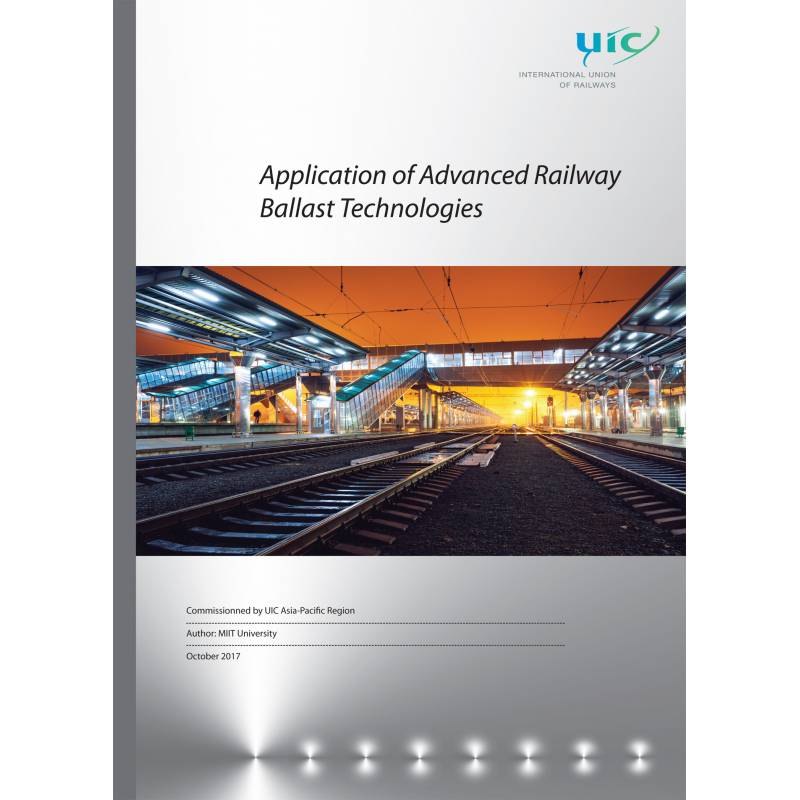
Application of Advanced Railway Ballast Technologies
The present report finalizes the result of the research that was organized on the basis of the decisions of the Asia-Pacific regional asembly of the UIC.
The background of the topic is of considerable importance for construction and maintenance of rail infrastructure under the conditions when roadbed design uses more and more geosynthetics materials. Advantage of those materials is the capacity to efficiently change the properties of roadbed soils in exact place for required features as geosynthetics provides roadbed with more stability. Geosynthetics includes a wide range of materials used for different purposes, so the efficiency of their use depends largely on the correctness of the choice of exact material and estimated calculated parameters. So the exact subject of the research was formulated as the use of geosynthetics materials forrein forcement of the roadbed of railways.
The objective of the research was to edit recommendations on the process of selecting the right geosynthetics material for reinforcement of the roadbed, as well as to edit standard solutions for different conditions of the use of geosynthetic materials.
The development of the project is deemed to enable the railways, thanks to correct choice of geosynthetic material, to:
- ensure reliability of designed structures;
- reduce time periods necessary for construction as well as the costs;
- reduce total expenditures for maintenance of rail track.
The research considered the main spheres of the use of geosynthetics for reinforcement of the roadbed:
- Reinforcement of roadbed in order to enhance stability of roadbed and strength of soils, as well as to reduce deformation;
- Separatings oils and elements of roadbed with creating a dividing membrane between soil layers of different kind, soils and ballast, soils and building elements (e.g. reinforcement plates), that will prevent smaller particles of soil from penetrating the layers with bigger particles;
- Thermal isolating of soils of a roadbed against freezing and frost blow up, and on the contrary against defrosting and strength loosing;
- Filtration and deflection of water from soils of the roadbed with geosynthetics by drying the soils of the roadbed in parallel and longitudinal sections;
- Hydraulic sealing of the soils of the roadbed or building elements in the roadbed against penetration of water;
- Vibration protection of track elements and of environment;
- Erosion prevention for soils of the roadbed against water and wind erosion. Relating to the location in infrastructure the use of geosynthetics was considered:
- On the main plate and upper work area of the roadbed (characterized by increased vibrodynamics loading, most important season temperature and humidity changes);
- In the body of the embankment under the workzone (to distribute tensions and to reduce deflected modes of basements);
- On slopes, in the banquettes, contre-banquettes (zones of maximum stretching normal and tangent tensions in the basements);
- In water evacuating, protective and reinforcing facilities.
The technical recommendations were edited with regards to geosynthetics, used for reinforcement of the roadbed depending on their purpose, place of mounting, and type of constructive element.
The practices of Russia and, to some extent, of Kazakhstan were studied, references to the experience of other countries were used as well.
The developed recommendations might be of practical importance for planning of construction and maintenance works at railways of Asia-Pacific members of the UIC.
| Author | UIC |
| ISBN | 978-2-7461-2660-2 |
| Pages | 116 |
Fiche technique
- Langage
- Anglais
- Format
- Téléchargeable
- Edition
- Ed. no.1
- Date d'édition
- 01/10/2017
- Date de publication
- 09/07/2018
- Nombre de pages
- 116
- Thème
- Asie-Pacifique
- sku
- 1-17008E-PDF
- Tailler papier
- 21 x 29,7cm
- Reference
- 1-17008E
 Préférences sur les cookies
Préférences sur les cookies

